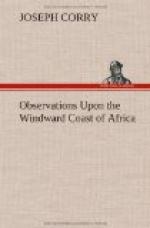It is impossible to contemplate the religious institutions, and superstitious customs of the western nations of Africa, north of the equator, without closely assimilating them with those of Ethiopia and Egypt; and from hence to infer that a correspondence has existed between the eastern and western inhabitants of this great continent.
SECTION II.
Of the Termite, Termes, or Bug a Bug, as it is called by the Natives upon the Windward Coast of Africa.
Among the insects mentioned in page 36, the termite, termes, or bug a bug, attracts peculiar notice. The following observations are derived from the investigations I occasionally made upon the Island of Tasso, attached to Bance Island, where they abound, and indeed in nearly all the western countries of Africa.
The oeconomy of nature, and the wisdom of Providence, are wonderfully displayed in these little animals; for although they occasion the utmost devastation to buildings, utensils, and all kinds of household furniture and merchandize, and indeed every thing except metal and stone, yet they answer highly important purposes in demolishing the immense quantity of putrid substances, which load the earth in tropical climates.
Their astonishing peculiarities cannot fail to excite the notice of an attentive observer; the sagacity and ingenuity they display in their buildings, their industry, and the plunder and devastation they commit, is incredible to those who have not witnessed their communities and empires. They are divided into innumerable societies, and acknowledge a king and queen, the former of which I brought to Europe, but the latter was by accident mislaid at sea. Linnaeus denominates the African bug a bug, Termes, and describes it as the plague of the Indies. Every community, as I have observed, has a king and queen, and the monarchy, if I may be allowed the expression, forms three distinct orders of insects, in three states of existence; of every species there are likewise three orders, which differ very essentially in the functions they have to perform, and are in appearance very different.
In their primitive state, they are perfectly white; they have six little feet, three on each side, and a small head, in which I could perceive no eyes, after a minute investigation with a microscope. In this state they supply the community with provisions from subterraneous cavities, fabricate their pyramidical buildings, and may with great propriety be called labourers.
In a few weeks they destroy the largest trunks of trees, carry away all descriptions of putrid substances, and particles of vegetable decay, which, in such a climate as Africa, amply compensates for the ruin which they otherwise occasion.
Their buildings are contrived and finished with great ingenuity and solidity, to a magnitude infinitely beyond the erections of man, when a comparative dimension of size is considered.




